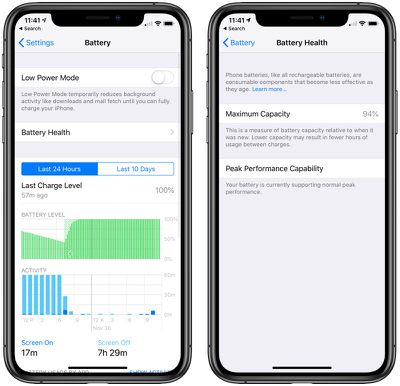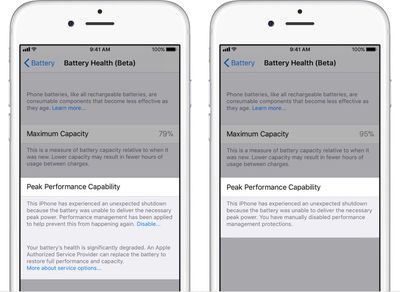If you have an iPhone that needs a battery replacement, it's a good idea to get it fixed soon as Apple's $29 battery replacement program is set to end on December 31, 2018.
Apple is still offering $29 battery replacements for the iPhone SE, 6, 6 Plus, 6s, 6s Plus, 7, 7 Plus, 8, 8 Plus, and X. All of these devices are eligible for a discounted $29 battery following the processor slowdown scandal that Apple faced earlier this year.
Battery Replacement Cost After Program Ends
After December 31, 2018, replacement iPhone batteries will return to regular price. For most iPhones, replacement batteries will be priced at $49, with the exception of the iPhone X. Apple will charge $69 for an iPhone X battery replacement.
The iPhone XS, XS Max, and XR are not eligible for $29 replacement batteries as these devices were released well after the battery issue first came to light and are still under warranty.
How to Initiate a Battery Replacement
To initiate a battery replacement, use Apple's battery support site. You can take your iPhone to an Apple retail store, an Apple Authorized Service Provider, or send it in for replacement at an Apple Repair Center.
With both replacement methods, Apple warns that it could take up to five business days, but in-store battery replacements are often completed more quickly. Some mail-in repairs can take as long as nine days.
Any damage that impairs the replacement of the battery, such as a cracked screen, will need to be repaired first before the battery can be swapped out for a new one.
Checking the Health of Your iPhone Battery
You can check on the health of your battery by opening up the Settings app, choosing the Battery section, and selecting "Battery Health."
The Battery Health option will let you know the exact maximum capacity of the battery in your iOS device and whether your iPhone is able to operate at Peak Performance Capability.

If the battery is not operating at Peak Performance Capability, you will see a recommendation for a battery replacement in order to restore the full functionality of the device.
Performance Management and Minimizing Shutdowns
iPhones that are not operating at peak performance can see random shutdowns due to a degrading battery's inability to keep up with processor demands at times of peak usage.
To prevent processor shutdowns, Apple introduced a performance management feature that throttles the processor of the iPhone when the battery cannot provide the power the processor needs.
Performance management does result in slower performance, and while the feature can be disabled by following these steps in an iPhone with a degraded battery, the only permanent fix is a new battery.

Apple initially implemented performance management quietly in the iOS 10.2.1 update in January 2017 and did not let customers know what was going on. The feature was discovered in late 2017, leading to customers who were outraged that Apple did not tell them their devices were being throttled.
There was a huge public upset, leading Apple to issue an apology and to provide the $29 battery replacement program. Apple has been offering no-questions-asked $29 battery replacements since December of 2017.
The Future of Performance Management
All iPhones will eventually face battery degradation issues due to the nature of lithium ion batteries. While performance management software was initially limited to the iPhone 6, 6 Plus, 6s, 6s Plus, 7, 7 Plus, and SE, Apple in iOS 12.1 added it to the iPhone 8, 8 Plus, and X to prevent future shutdowns should these devices suffer from failing batteries.
In the iPhone 8, 8 Plus, and X, performance management features introduced due to degraded batteries "may be less noticeable" because of their "more advanced hardware and software design."
Future iPhones, such as the iPhone XS, XS Max, and XR, will also eventually receive performance management software until battery technology improves.























